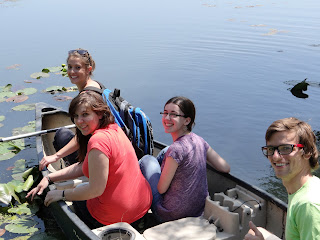This is the tale of the elusive, carnivorous purple pitcher plants, or Sarracenia purpurea, who claim strange domain upon the floating peat islands of the Brook Lodge fen. Pitcher plants are, as one may assume, pitcher shaped, and suitably so, as they purvey rain water to provide for populations of peculiar prey within their perilous bowels.
 |
| Observe the perilous pitcher plant in its natural habitat! Aren't the flowers pretty? Pretty misleading, if you ask me... |
Of course, these voracious, violet creatures are absolutely harmless... That is unless one is senseless enough to slip into one for a quick swim or to rest, like an insect looking for somewhere shady and discrete. Even then, it's truly the plethora of microbes who digest any hapless intruders, not the purple pitcher plant. Among the bold souls actually attempting to live therein are small, hairy protozoans who call themselves Colpoda. Well, really, we call them colpoda, as they don't talk, and they aren't so much hairy as they are ciliated... but they are small–microscopic even!
| Here are some now, right under a microscope! |
Here begins the story of our ecology class, and how we learned of these heroic colpoda...
One sunny afternoon, we embarked out on a journey through the fens, fending off misquitoes as we navigated our boats carefully to the fabled floating peat moss islands. Pulling up alongside, we found the pitcher plants in numbers so great, we were too afraid to go ashore the islands. I was just the helmsman of my canoe, but remember it all well– our daring crew using only a pipette and a steady hand pulled the rain water vile with microbes and detritus out and locked it in the most secure vials aboard the vessel.
Once back at port, we Grand Caravanned back to the lab to set up an experiment. Our scheme was simple, we were to see how well these colpoda would survive when pitted against the their arch nemesis, the dreaded mosquito larvae. We then intended to contrast this grim treatment by giving others a surplus of decidedly delicious fish food. Naturally, we kept a sample as natural as possible, giving them nothing but an environment and our control.
Though our data were slightly biased by sampling techniques and starting populations, we were filled with fascination as we finished the experiments. The control group grew steadily, but were altogether not particularly remarkable. Those populations living in lush excess were found growing at accelerated rates, rising to levels more impressive than any of the other groups. However, both of these pale in comparison to the excitement experienced by the hardy colpoda engaged with the villainous mosquito larvae. These valiant individuals held strong against constant predation for four long days, eventually giving way on the fifth and losing most, if not all, of their numbers.
Every tale deserves a fine ending, and this is certainly the finest.
Every tale deserves a fine ending, and this is certainly the finest.
The end.
Thank you for reading.
–Al Manner–

No comments:
Post a Comment